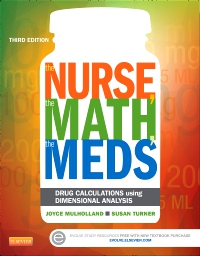
The Nurse, The Math, The Meds, 3rd Edition
Paperback

Now $67.45
Use the simplicity of the dimensional analysis method to minimize drug calculation errors! The Nurse, The Math, The Meds, 3rd Edition helps you overcome any math anxiety you may have by clearly explaining how to use the dimensional analysis method. It shows how to analyze practice problems, find the reasonable answer, and then evaluate it. But first, it lets you refresh your math skills with a review of essential math. Written by noted nursing educator Joyce Mulholland, this book offers over 1,400 questions for plenty of practice in mastering math concepts and learning dosage calculations.
-
- Mnemonics throughout the text facilitate memorization and conserve learning time.
- Red arrow alerts call attention to critical math and patient safety theory to increase student awareness of potential errors and patient safety issues.
- High-risk drug icons serve as visual reminders of high-risk drugs in the text.
- UNIQUE! FAQs and answers break up the text, add to comprehension, and provide additional necessary knowledge for students studying both inside and outside of a classroom environment.
- UNIQUE! Ask Yourself questions synthesize and reinforce comprehension of content.
- UNIQUE! Communication boxes display sample nurse-patient, nurse-prescriber dialogues that help reduce medication errors and relate the math to the medications and to clinical application.
- Multiple-choice review at the end of each chapter supplies a multiple-choice format review for NCLEX exam preparation.
- Chapter final supplies you with a final practice over material covered in the entire chapter so you can evaluate understanding of chapter content.
- Comprehensive final practice at the end of the text covers major concepts and offers additional practice for overall evaluation of learning.
- Rapid Practice exercises follow each new topic presented in each chapter to encourage and allow drug calculation and math concepts to be completed in one sitting.
- Consistent chapter format provides you with a quick overview of chapter contents including objectives, estimated time to complete chapter, an introduction and essential vocabulary.
- A comprehensive math review section includes a self-assessment test designed to help you identify areas of strength and weakness in competency of basic math.
- Early introduction of the dimensional analysis method with basic practice problems in chapter 2 facilitates application of the dimensional analysis method to various types of medication-related calculations.
- TJC and ISMP recommendations help reduce medication errors, increase patient safety, and ensure compliance with agency regulations.
- Full-color design, bold print, boxed material, and ample space to work out the practice problems make navigating chapters easy and mastering content more effective.
- Test tips throughout the text enhance comprehension and improve test-taking skills.
- Cultural boxes describe selected math notation and medication related cultural practices to help reduce math-related reading errors while broadening your cultural perspective.
- Clinical Relevance boxes expand your perception of the medication-related nurse’s role while motivating interest, and increasing awareness of safety issues.
- Website and other applicable references at the end of each chapter offer extra resources for further medication-related theory.
-
- NEW and UPDATED! Examples in Dimensional Analysis Method chapter have been revised for clarity with consistent format of equations.
- NEW and UPDATED! Practice problems in parenteral nutrition, advanced intravenous calculations, anticoagulants, blood administration, diabetic meds, and pediatric have been incorporated throughout the text.
- NEW and UPDATED! Medication labels and photos keep you up-to-date on the latest medications in use today.
- NEW and UPDATED! Current medication-related patient safety trends from QSEN, TJC, ISMP and NLN.
- NEW! Reorganized answer key places answers and the work to practice problems at the end of each chapter for easier accessibility.
-
PART I: MATH REVIEW FOR MEDICATION CALCULATIONS Math Self-Assessment 1. Math Review 2. Dimensional Analysis Method
PART II: MODERN METRIC SYSTEM AND MEDICATION CALCULATIONS 3. Measurement Units and Conversions 4. Patient Records, Medication Orders, and Medication Labels
PART III: RECONSTITUTED MEDICATIONS 5. Oral Medications 6. Syringe Measurements 7. Reconstitution of Medications
PART IV: PARENTERAL MEDICATIONS 8. Injectable Medications 9. Basic Intravenous Calculations 10. Advanced Intravenous Calculations
PART V: COMMON HIGH-ALERT MEDICATIONS 11. Diabetic Medications 12. Anticoagulant Medications
PART VI: MEDICATIONS FOR INFANTS AND CHILDREN 13. Pediatric Medications
Comprehensive Final Practice
Appendix A: TJC Do Not Use List Appendix B: ISMP List of High-Alert Medications Appendix C: 5-Minute Sample Verbal Communication Hand-Off Report Appendix D: Sample Medication Error Chart with Implications Appendix E: Apothecary System Measurements
Index

 as described in our
as described in our 